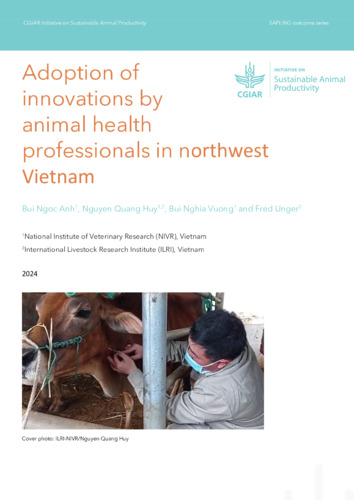Adoption of innovations by animal health professionals in northwest Vietnam
Abstract
The Sustainable Animal Productivity for Livelihoods, Nutrition and Gender Inclusion (SAPLING), also known as Chăn-Hênh in Vietnam, is a CGIAR initiative that aims to contribute to the transformation of livestock sectors in target countries, making them more productive, resilient, equitable and sustainable. In Vietnam, the initiative is focusing on the pig, beef and chicken value chains, selected based on the following factors (Atieno et al. 2024; Huyen et al. 2022):
(i) Building on the CGIAR Livestock Research Program (‘Livestock-led interventions towards equitable livelihoods and improved environment in the northwest highlands of Vietnam’, also known as the Li-Chan project);
(ii) Stakeholder prioritization, which aligns with the provincial livestock development strategy (determined during a SAPLING consultation meeting in July 2021); and
(iii) Government and donor interests.
Pigs and cattle are an important source of income for smallholder farmers in the northwest highlands of Vietnam. They are key value chains for improved livelihoods and food security but record low productivity due to poor husbandry practices, diseases, parasites and inappropriate technologies (feed, breeds and herd health). Improved forages, animal breeding, herd health and markets have demonstrated sustainable gains in on-farm productivity but need to reach impact at scale. One of the Chăn-Hênh objectives is to improve the beef cattle and pig value chains (Atieno et al. 2024; Huyen et al. 2022). Towards this end, a two-day training workshop equipped local animal health professionals (AHPs) with the necessary veterinary knowledge and practical skills (Anh et al. 2024b). In addition, some AHPs also participated in farmer training on biosecurity and animal health and were involved in on-farm demonstrations (Anh et al. 2024a). This report presents animal health outcomes, including (i) the number of households that received animal health innovations through trained service providers and (ii) the number of households where AHPs applied improved vaccination techniques during livestock vaccination campaigns. All 16 AHPs adopted a wide range of animal health technologies provided by the training. From the beginning of 2024 to the end of October 2024, they provided improved veterinary services, including diagnosis and treatment, deworming and vaccination to 800 households, with an average household size of 4.8 people (Hammond et al. 2021), benefiting 3,840 people. In January-October 2024, using their enhanced skills, the AHPs vaccinated 2,527 cattle from 1,242 households in Son La Province. With an average household size of 4.8 people (Hammond et al. 2021), this directly benefited around 6,000 farmers and household members.

